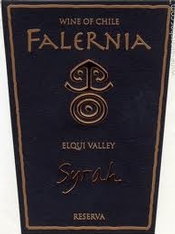Viña Falernia, Elqui Valley (Chile) Syrah Reserva 2009 (Empson USA, $12): This Syrah from Chile embodies two exciting trends: the emergence of Syrah as an important red wine for Chile and the development of new vineyard regions that push Chilean viticulture  beyond the confines of the Central Valley. It also embodies the vision of two pioneers who believe that a remote, challenging region can produce world-class wines.
beyond the confines of the Central Valley. It also embodies the vision of two pioneers who believe that a remote, challenging region can produce world-class wines.
The Elqui Valley is Chile’s northernmost wine region, situated on the southern edge of a particularly arid dessert. Unusually in Chile, the valley runs east-west, because of a shift in the direction of the coastal mountains. The climate is dry — rainfall averages only about four inches per year — but the maritime influence brings the moisture of fog to vineyards near the coast, as well as cool temperatures. Inland, the climate becomes warmer, dryer and windier as the valley narrows; the vineyards go higher in altitude, up to more than six thousand feet. Night temperatures inland are very cool and the skies are so clear, day and night, that several planetary observatories are situated here. Soils are so low in fertility that in some places the land suggests a moonscape.
Originally, the Elqui Valley grew grapes only for Chile’s famous Pisco brandy, such as Muscat and Pedro Ximinez. Aldo Olivier Gramola settled in the area in 1951 and began growing grapes for Pisco in 1975. More than two decades later, Giorgio Flessati, a winemaker from Italy’s Trentino region, joined him to plant vines for fine wines and create, in 1998, Viña Falernia, the region’s first — and still, its only — fine wine estate. Despite the handicap of a truly remote location, their project gained fame in 2005, when one of their Syrahs won the trophy as not only Best Syrah of the annual Wines of Chile Awards competition but also the Best of Show wine.
Viña Falernia makes several red and white wines, but its flagship variety is Syrah, and that grape represents about 35 percent of the company’s vineyards. The winery makes three Syrah varietal wines, of which this Reserva is the middle tier; it also makes a Camernère-Syrah blend (the Carmenère often produced partially from dried grapes, in the tradition of Italy’s Veneto region) and a Cabernet Sauvignon-Carmenère-Syrah blend. This Syrah Reserva comes from grapes grown in three of the winery’s four vineyards, each at separate locations along the Elqui Valley, with a predominance of fruit from the coolest vineyard, eleven miles from the ocean.
The wine has an aroma of red fruits, roasted meat and black pepper spice, with a suggestion of tanned leather and oak perfume, for a classic and complex varietal nose. In your mouth it is dry and nearly full-bodied, with silky texture as well as the grip of fine-grained tannins. Flavors of dark fruit, spice, inky minerality and leather are concentrated, clean, fresh and vivid and they persist across the palate into a flavorful finish. The flavors dominate the wine’s tannins, even as the tannins lend a gutsy backdrop to the flavors. Altogether the wine is vibrant, flavorful, and very well-balanced. When I tasted this wine a year ago, winemaker Flessati described it as a Syrah in the “tight style,” and its acidity and tannins do make for a trim structure. But now the fruit character has opened to diminish the impression of structural tightness.
The vivid fruit character of this wine emerges from winemaking techniques such as a cold maceration of about four days prior to fermentation, which enlivens the aromas, and partial wood aging (only 45 percent of the wine) in French oak barrels, most of which are not new.
90 Points
